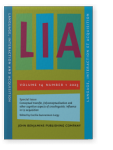Crosslinguistic differences in initial word
recognition
A comparative study of French learners of Polish and Arabic
The present article addresses the extent to which learners’
mental representations, in particular the phonological and lexical
representations of learners’ background languages, influence their ability to
perceive and extract linguistic units from a novel speech stream. In the study,
native speakers of French were exposed to an unfamiliar language, either Polish
or Modern Standard Arabic. A word recognition test taken at first exposure
revealed important differences in how French speakers/listeners extract words
from the Polish or Arabic speech stream, suggesting that source language
representations work differently depending on the specificities of the target
language. In addition to providing insights into the effects of source and
target language properties on speech perception, these results contribute to
on-going discussions about what constitutes crosslinguistic influence and
conceptual transfer in second language acquisition research.
Article outline
- 1.Introduction
- 2.Theoretical background and previous studies
- 2.1Conceptual transfer and crosslinguistic influence
- 2.2Phonological representations
- 2.3The role of lexical transparency in word recognition
- 2.4Phonological features of SL French and TLs Polish and Arabic
- 3.Method
- 3.1The participants
- 3.2The experimental procedure
- 4.Results
- 4.1Overall score
- 4.2Transparency score
- 4.3Crosslinguistic differences
- 4.3.1Category 1
- 4.3.2Category 2
- 4.3.3Category 3
- 5.Discussion
- 5.1Transparency
- 5.2Vocalic and consonantal systems
- 5.3Syllabic structure and phoneme combination
- 5.4Environment of the target word in the sentence
- 5.5Summary and future research
- 6.Conclusion
- Acknowledgements
- Notes
-
References
